The Farndon Massacre
A somewhat dark and dour postcript to the Battle of Naseby.
War is a dreadful thing, amongst all of the horrific things that human inflicts upon other human in the name of 'war' there are some events that stand out as atrocities: one such atrocity took place in the aftermath of the battle of Naseby.
There are many atrocities attributed to one side or the other during the Civil Wars, but when you look into most of these atrocities, hard evidence can be hard to find to support the hyperbole of the pamphleteers.
 |
| An oft recycled pamphlet image of an atrocity: originally used for an event in the south west, then Leicester, then York. |
The events that befell the Royalist baggage train after Naseby are fairly unique in that both sides report pretty much the same story, and a 1660 Petition to Charles II supports the story.
Naseby is all but lost and panicking Royalist troops start fleeing north towards Market Harborough, and the baggage train flees too. Anyone who has ever walked the terrain will know that carts and wagons are not going to make much headway over the ground, so they head east along Sibbertoft Road towards Clipston, in order to join the road north to East Farndon, Market Harborough and the relative safety of the garrison at Leicester.
The baggage train wasn't just carts stuffed with the belongings of the great and good, there were large numbers of camp followers too: soldiers wives and children, household servants, and it is inevitable that there would have been some ladies plying the oldest profession too.
 |
| The Royalist Baggage on Sturt's version of Streeter's Plan* |
Streeter puts the Royalist baggage in the vicinity of Sibbertoft Road and behind Dunst Hill: whilst Streeter's Plan is not totally accurate it is pretty good at giving rough approximations of locations.
The Army Newly Modelled were fuelled on anti Irish xenophobic propaganda in the newsheets; fear of witchcraft, again courtesy of newsheet propaganda and the pulpit; religious fervour and the need to punish immoral women; and, as Mark Stoyle (The Road to Farndon Field, English Historical Review Vol 123 No 503) argues a desire for revenge for the treatment of Essex's camp followers in the West Country.
When they caught up with the fleeing Royalist camp followers they killed at least a hundred of them (some reports say as many as 400), and savagely mutilating many more.
Parliamentarian pamphleteers in London made no apology for what their soldiers had done, but rather triumphed in their murderous actions:
The Irish women Prince Rupert brought on the field (wives of the bloody Rebels in Ireland, his Majesties dearly beloved subjects) our soldiers would grant no quarter too, about 100 slain of them, and most of the rest of the whores that attended that wicked Army are marked in the face or nose, with a slash or cut.
The accounts of 'Irish', 'whores' and 'witches' in the Royalist camp being routinely repeated in contemporary pamphlets, and continues in text books to this day.
Is there any evidence for the Parliamentarian claims of the makeup of the camp followers? Not really, certainly nothing that can even remotely 'justify' such an atrocity even by the standards of the day. Not that anything could.
In May 1660 Bridget Rumney submitted a petition to the newly-restored King Charles II, in which she begged that she herself might be restored to the position at Court which she had enjoyed during the reign of his father.
Bridget explaining that she and her mother, Elizabeth Burgess, had been members of the royal household, in the Office for providing of 'flowers and sweete herbes for the Court’ for both James I and Charles I.
Bridget's petition continues explaining that her mother (Elizabeth Burgess) and two of her own sons ‘ were 'slayne at Nazebie’. This petition and supporting evidence clearly puts Bridget and her family with the baggage train and have her as an eye witness to the events that unfolded.The ‘Irish women’ were most likely Welsh speakers rather than Irish, as approximately half of the Royalist foot appear to have been Welsh.
A small number of Royalist sources also report the same story, but with a very different spin on the massacre, describing those who were killed as ‘women and soldiers’ wives’.
It is, however, almost inevitable that there would be some sex workers who had been 'following the money' amongst the camp followers.
>>>>>>
But where did this brutal event take place?
In the south part of Farndon-field, within the gate-place in the road between Nasebie and Farndon
(Nichols, The History & Antiquities of the County of Leicestershire, Vol 2: quoting Morton)
Which isn't particularly helpful.
So where could 'the gate-place' be? Glenn Foard (Naseby The Decisive Campaign) quotes an C19th source which has local people pointing out a place where these events took place.
Professor Andy Hopper argues that the camp followers were killed in a rare enclosed field, on the north side of Sibbertoft Road.
Both Hopper's and Foard's cryptic clues, along with Morton's description are suggestive of the area around Clipston.
Foard describing C19th locals pointing out the place of the slaughter; even today most of the route from Dunst Hill towards Farndon is free from even the smallest of settlements, other than Clipston. Whilst an oral tradition could be anywhere along this route, it is more likely to be where people live or work.
Morton's description: Historic England describes the medieval settlement of Clipston in great detail, lots of earthworks, the remains of the medieval ridge and furrow, and stock enclosures. Most importantly the roads through the settlement are described as hollow ways, with Harborough Road being described in an archaeological survey of 1980/1 as being bounded on either side with low banks, ditches and scarps .
A settlement of this size and complexity must have had some wealth associated with it, and whilst it is an assumption, might be a suitable location for a 'gate-place'. Even if there was never an actual gate, the description of Harbourgh Road in particular is a marked entrance into the village. I can find no other sites along the road that might be a contender for a 'gate-place'.
Hopper's 'rare enclosed field' also fits the Clipston medieval site: with two enclosed fields north of the Sibbertoft Road.
One on the western outskirts of Clipston, appears to have been the location of a windmill, so less likely as the location: why would Morton describe the location as 'the gate-place' if a windmill stood on the site, surely he'd describe the place as at the windmill? Another 'enclosed field' is located at the eastern most end of Sibbertoft Road (a better description would be is west of Harborough Road). Both of which appear on the Ordnance Survey maps First Edition Series (circa 1860ish). More widespread enclosure did not take place in the area until the late C18th, even by the latter half of the C19th there are few field boundaries marked on the OS map. A medieval enclosure bounded by earthworks is also clearly marked slightly further along Harborough Road on the edge of the medieval Clipston boundary.
Whilst the evidence is circumstantial, the general area of north west of the Sibbertoft Road/Harborough Road junction in Clipston seems a very likely contender for this most brutal of events. Perhaps we will never know exactly where these events took place - an archaeological survey would have to cover a vast area to pinpoint the location, assuming that any evidence still remains in the ground.
Overlooked by many battlefield tours, surely this general area should have some sort of memorial to those innocents who were so brutally killed in these parts?
* As I don't own a copy of Streeter's Plan, you will have to cope with a picture of my original Sturt version. They're more or less the same.
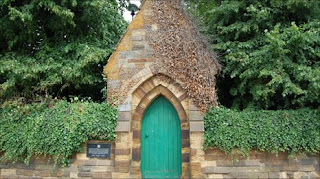
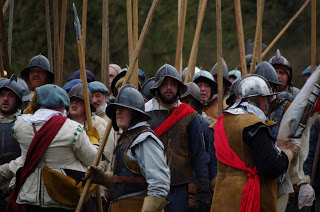
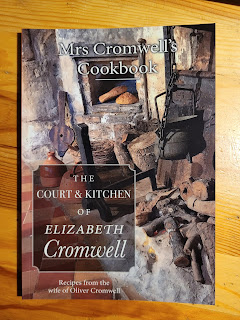



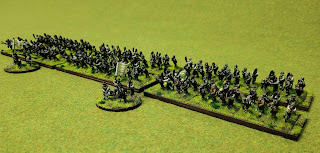

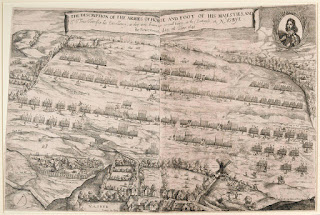
Very sad event and as you say not mentioned much and certainly not part of the tour I went on last year. You are right, these events do need to be remembered and recorded. Paul
ReplyDeleteThought provoking post... well done, it's always good to remember the bigger picture, and that it's not all bravely fluttering flags, drums, and trumpets..
ReplyDelete